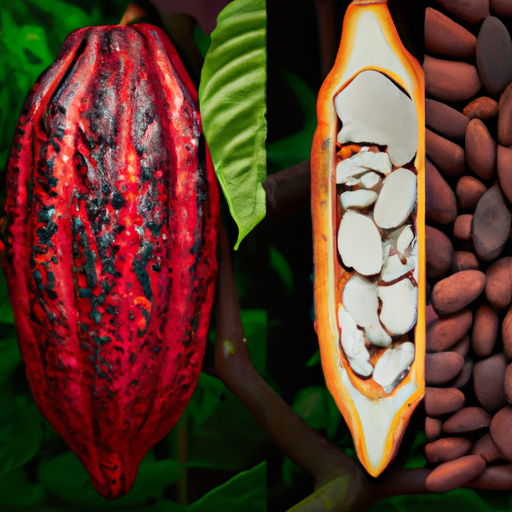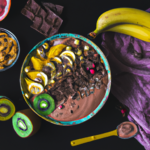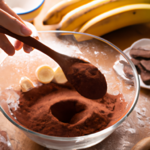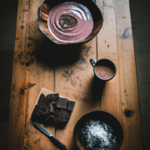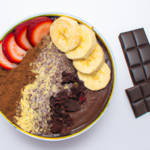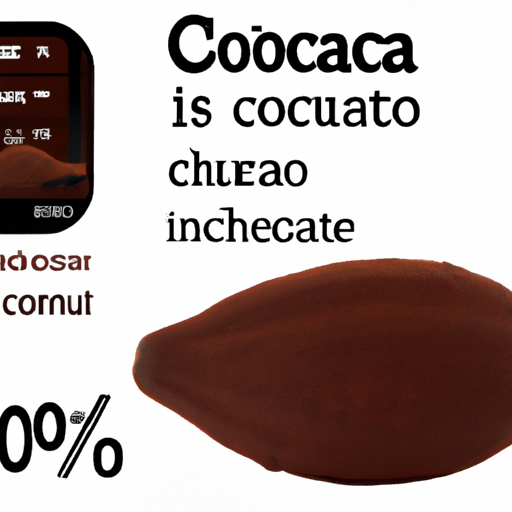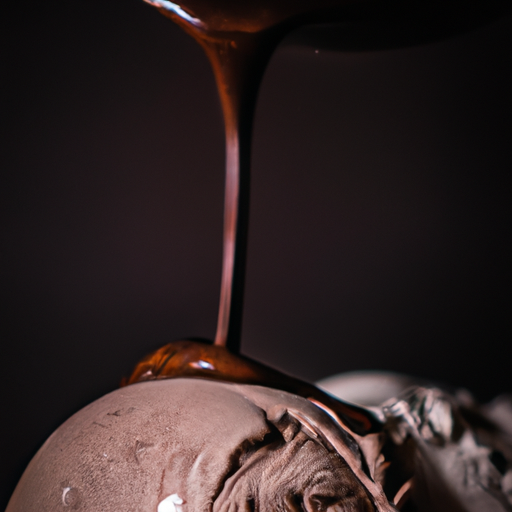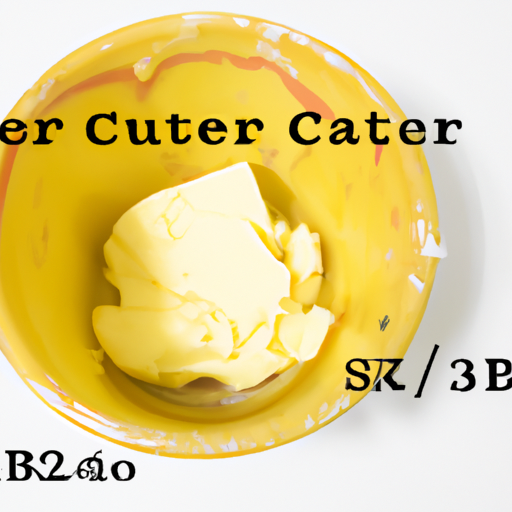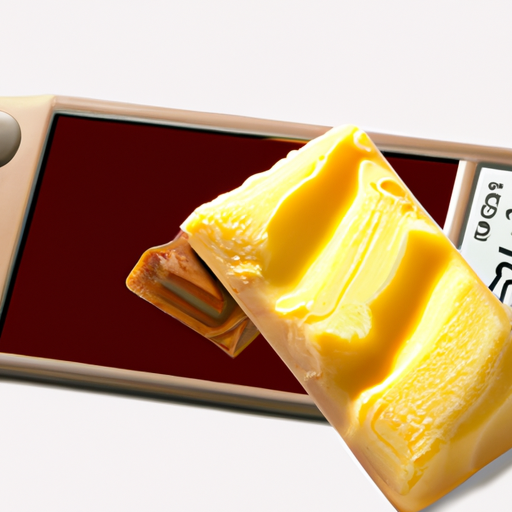Having raw cacao can provide multiple health advantages. Raw cacao is rich in antioxidants, magnesium, and other important minerals that can enhance your mood, sharpen your focus, and promote heart health.
If you’re looking for a delicious and nutritious way to enjoy the benefits of raw cacao, look no further than warm raw cacao. In this article, I will guide you through the simple steps to make a warm and indulgent cup of raw cacao that will satisfy your chocolate cravings while nourishing your body.
From choosing the best raw cacao powder to adding your favorite flavor enhancements, I will share all the tips and tricks you need to create the perfect cup of warm raw cacao.
So, grab your mug and let’s get started!
Key Takeaways
- Garnishes such as whipped cream, shaved dark chocolate, cinnamon sprinkle, and fresh berries can enhance the taste and provide health benefits to warm raw cacao.
- Experimenting with different variations, such as adding cinnamon and cayenne pepper for a subtle kick, crushed almonds or hazelnuts for added crunch and nutty taste, or peppermint extract for a refreshing twist, can result in finding the perfect blend.
- The key to making warm raw cacao is to enjoy the process of discovering the combination that suits your taste buds.
- Warm raw cacao garnished with whipped cream is rich in calcium, shaved dark chocolate is high in antioxidants, cinnamon sprinkle helps regulate blood sugar, and fresh berries are packed with vitamins.
Gather Your Ingredients
Now, imagine yourself in your cozy kitchen, gathering all of your ingredients for your warm raw cacao.
When it comes to sweetening your cacao, you have a variety of options. Natural sweeteners like raw honey, maple syrup, or coconut sugar are popular choices. They add a touch of sweetness without overpowering the rich flavors of the cacao. If you prefer a sugar-free option, you can use stevia or monk fruit sweetener.
When selecting your raw cacao powder, it’s important to choose a high-quality brand. Look for organic and fair-trade options to ensure you’re getting the best quality product. Check the label for any additional ingredients or fillers. A pure and unadulterated cacao powder will provide the most authentic flavor and health benefits.
So, let’s move on to the next step and choose high-quality raw cacao powder.
Choose High-Quality Raw Cacao Powder
To ensure the best flavor and health benefits, opt for a high-quality raw cacao powder. It contains a surprising amount of antioxidants. Not all cacao powders are created equal, so choose one that is minimally processed and free of additives.
Here are some tips for selecting the best raw cacao powder:
- Look for organic and fair trade certifications to ensure ethical sourcing.
- Check the ingredient list for added sugars or artificial flavors.
- Consider the origin of the cacao beans, as different regions produce unique flavors.
In addition to its rich taste, raw cacao powder offers several health benefits. It is packed with nutrients like magnesium, iron, and fiber, which support heart health and improve digestion. Raw cacao powder also contains theobromine, a natural stimulant that can boost mood and energy levels.
Now that you have your high-quality raw cacao powder, let’s move on to the next step: heating up your milk or milk alternative.
Heat Up Your Milk or Milk Alternative
Start by gently heating up your favorite milk or milk alternative, creating a comforting and indulgent experience for your taste buds.
When it comes to choosing a milk alternative, there are a variety of options available such as almond milk, oat milk, or coconut milk. Each alternative offers its own unique flavor and texture, so feel free to experiment and find the one that suits your preferences best.
Once you’ve chosen your milk or milk alternative, you can take it a step further by frothing it at home. This can be done using a handheld frother or by heating the milk in a saucepan and whisking vigorously. Frothing adds a creamy and velvety texture to your warm raw cacao drink.
With your milk heated and frothed to perfection, you’re now ready to move on to the next step of adding raw cacao powder and sweetener.
Add Raw Cacao Powder and Sweetener
To add raw cacao powder and sweetener to your warm drink, follow these steps:
-
Choose your sweetener: Options include honey, maple syrup, agave nectar, or coconut sugar. These alternatives not only add a delightful taste but also provide some health benefits.
-
Measure out your desired amount of raw cacao powder. Unlike processed cocoa powder, raw cacao powder is packed with antioxidants, iron, magnesium, and other essential nutrients. These nutrients can boost your mood, improve cognitive function, and support heart health.
-
Add the raw cacao powder to your warm drink. This will not only satisfy your chocolate cravings but also give your body a nutritious treat.
-
Add your chosen sweetener to taste. Experiment with different amounts until you achieve your desired level of sweetness.
-
Mix well until your drink becomes smooth and creamy.
Enjoy the indulgent combination of rich raw cacao and natural sweetness in your warm drink.
Mix Well Until Smooth and Creamy
Once blended thoroughly, the result is a lusciously smooth and velvety concoction that will leave your taste buds begging for more. To achieve this creamy texture, there are two popular methods: the blender technique and the whisking method. Let’s explore each one:
-
Blender technique: This method involves adding the ingredients to a high-speed blender and blending them until smooth. The blender’s powerful motor ensures that the cacao powder and sweetener are fully incorporated, resulting in a silky consistency.
-
Whisking method: If you don’t have a blender, you can use a whisk instead. Start by adding the cacao powder and sweetener to a bowl. Then, vigorously whisk the mixture until it becomes smooth and creamy. This method requires a bit more elbow grease but can still yield excellent results.
Now that we have our smooth and creamy cacao base, we can move on to the optional step of adding flavor enhancements.
Optional: Add Flavor Enhancements
To enhance the taste of your creamy cacao base, you have the option to add flavor enhancements. This can be a creative and enjoyable experience as you experiment with different combinations. Some ideas to consider are sprinkling in a pinch of aromatic spices or infusing it with a hint of exotic essence. These additions can transform your cacao into a tantalizing symphony of flavors.
For a warm and comforting taste, try adding a dash of cinnamon. This will give your cacao a cozy and inviting flavor. Alternatively, a touch of vanilla extract can provide a sweet and fragrant aroma.
If you enjoy a bit of heat, consider incorporating a hint of chili powder for a spicy kick. This will add a bold and exciting element to your cacao. On the other hand, a sprinkle of sea salt can enhance the richness of the cacao, creating a more complex and satisfying taste.
The possibilities for flavor enhancements are endless, so feel free to explore and discover your own unique combination. Once you have achieved the perfect flavor profile, pour your delicious creation into your favorite mug and savor every sip.
Pour into Your Favorite Mug
After adding flavor enhancements to my warm raw cacao, it’s time to pour it into my favorite mug. This step not only adds a touch of personalization to my drink but also enhances the overall experience of savoring the rich, velvety goodness.
When choosing a mug for enjoying warm raw cacao, there are a few factors to consider. Firstly, opt for a mug that is large enough to hold a generous serving of cacao, allowing you to fully indulge in its delightful flavors. Secondly, look for a mug with a handle that provides a comfortable grip, making it easier to enjoy every sip. Lastly, consider using a mug that is made of heat-retaining material like ceramic or porcelain, as it will help keep your cacao warm for longer.
Here are the best mugs for enjoying warm raw cacao:
- A handmade ceramic mug with a unique design that adds aesthetic appeal to your drink.
- A double-walled glass mug that allows you to appreciate the rich color of the cacao while keeping it warm.
- A large, cozy mug with an oversized handle for a comforting drinking experience.
- A travel mug with a tight-sealing lid, perfect for enjoying warm raw cacao on the go.
Drinking warm raw cacao in the morning offers numerous health benefits, such as boosting mood, improving cognitive function, and providing a natural source of antioxidants. So, grab your favorite mug filled with warm raw cacao, garnish it to your liking, and get ready to savor this nourishing beverage.
Garnish and Enjoy
Indulge in the exquisite pleasure of garnishing and relishing your velvety warm raw cacao, as you add the final touches to your personalized mug. As you sip on this heavenly concoction, let your taste buds dance with delight and your body revel in the health benefits of raw cacao. To enhance the visual appeal and flavor of your warm raw cacao, consider these garnish ideas:
| Garnish Ideas | Health Benefits |
|---|---|
| Whipped cream | Rich in calcium |
| Shaved dark chocolate | High in antioxidants |
| Cinnamon sprinkle | Helps regulate blood sugar |
| Fresh berries | Packed with vitamins |
These simple additions not only elevate the taste, but also provide a host of health benefits. Now, as you relish each sip of your warm raw cacao, why not experiment with different variations to discover your perfect blend?
Experiment with Different Variations
Explore the realm of endless possibilities by trying out various combinations to discover your ultimate personalized blend of warm raw cacao. Here are three alternative variations to consider for your taste testing pleasure:
-
Spiced Delight: Add a pinch of cinnamon and a dash of cayenne pepper to your warm raw cacao. These spices will give your drink a subtle kick and enhance the chocolate flavor.
-
Nutty Indulgence: Sprinkle some crushed almonds or hazelnuts on top of your warm raw cacao. The added crunch and nutty taste will take your drink to a whole new level of deliciousness.
-
Minty Freshness: Stir in a few drops of peppermint extract into your warm raw cacao. This refreshing twist will leave you feeling invigorated and satisfied.
Remember, the key is to experiment and find the combination that suits your taste buds. So go ahead, get creative, and enjoy the process of discovering your perfect warm raw cacao blend!
Frequently Asked Questions
How long does it take to heat up the milk or milk alternative?
It typically takes about 2-3 minutes to heat up milk or milk alternatives for warm raw cacao. Some popular milk alternative options include almond milk, coconut milk, and oat milk.
What are some examples of flavor enhancements that can be added?
Some examples of flavor enhancements that can be added to warm raw cacao are cinnamon, vanilla extract, and a pinch of sea salt. These combinations not only add deliciousness, but also provide various health benefits.
Can I use regular cocoa powder instead of raw cacao powder?
Oh sure, you can totally use regular cocoa powder instead of raw cacao powder…if you want to miss out on all the amazing nutritional benefits! But hey, who needs antioxidants and minerals, right? As for storage, just keep them in a cool, dry place to maintain freshness. Now, back to making that warm raw cacao!
What is the recommended amount of sweetener to add?
The recommended amount of sweetener to add to warm raw cacao depends on personal preference. Some alternatives to sugar include honey, maple syrup, or stevia. Experiment with different amounts to find your desired level of sweetness.
Are there any specific variations that you recommend trying?
There are numerous flavored cacao options to try, such as adding cinnamon or vanilla extract. Besides their delicious taste, these variations offer additional benefits like antioxidant properties and mood-boosting effects due to the use of raw cacao.
Can I Use Raw Cacao Blocks to Make Warm Raw Cacao Drink?
Yes, you can use raw cacao blocks for preparing raw cacao drink. Simply grate the desired amount of raw cacao block into a saucepan, add your choice of milk, and gently heat while stirring until the cacao has melted. Add sweetener if desired, then pour and enjoy!
Conclusion
In conclusion, making warm raw cacao is a simple and delicious way to enjoy the benefits of raw cacao powder. By choosing high-quality raw cacao powder and heating up your milk or milk alternative, you can create a smooth and creamy beverage that is packed with antioxidants and nutrients.
One interesting statistic to note is that raw cacao has been found to contain more than 300 different compounds, including vitamins, minerals, and phytochemicals that can improve overall health.
So why not give warm raw cacao a try and experience its amazing taste and health benefits for yourself?


